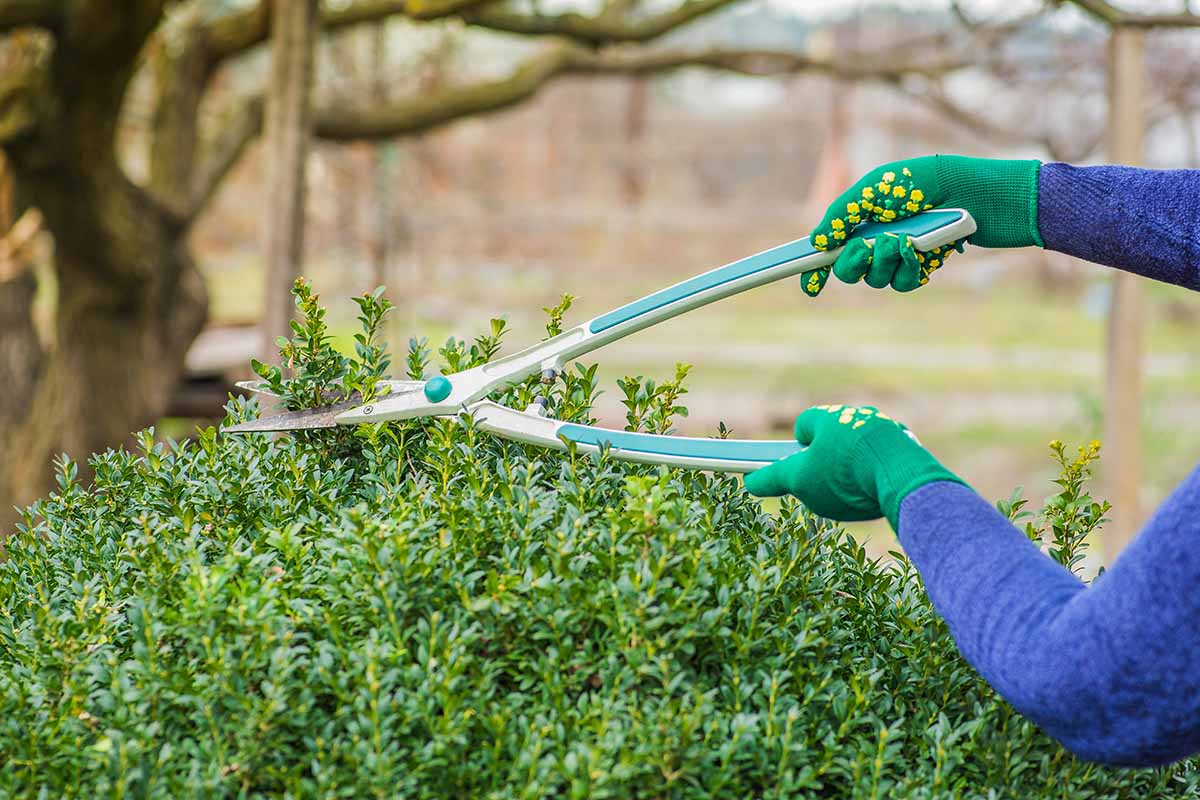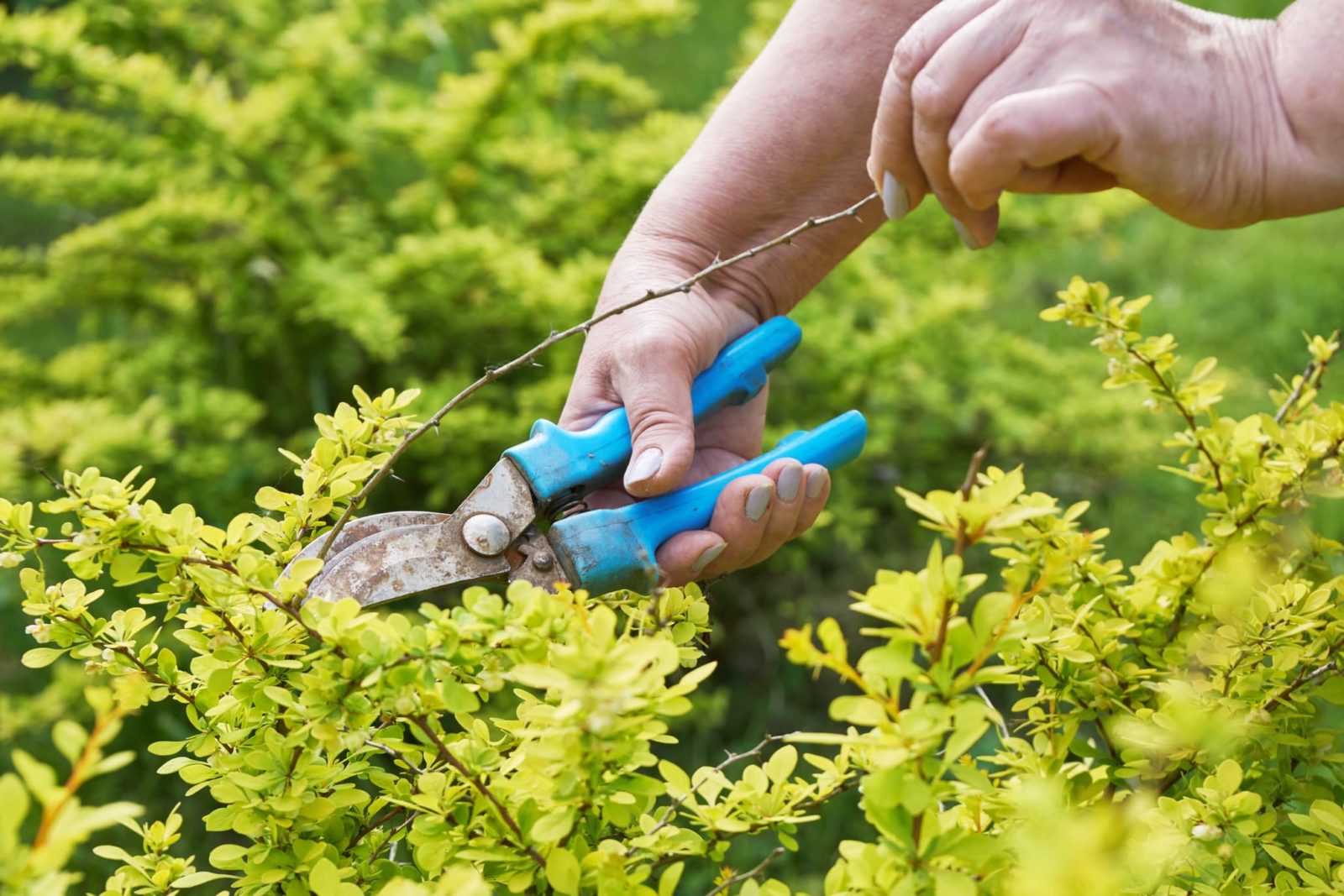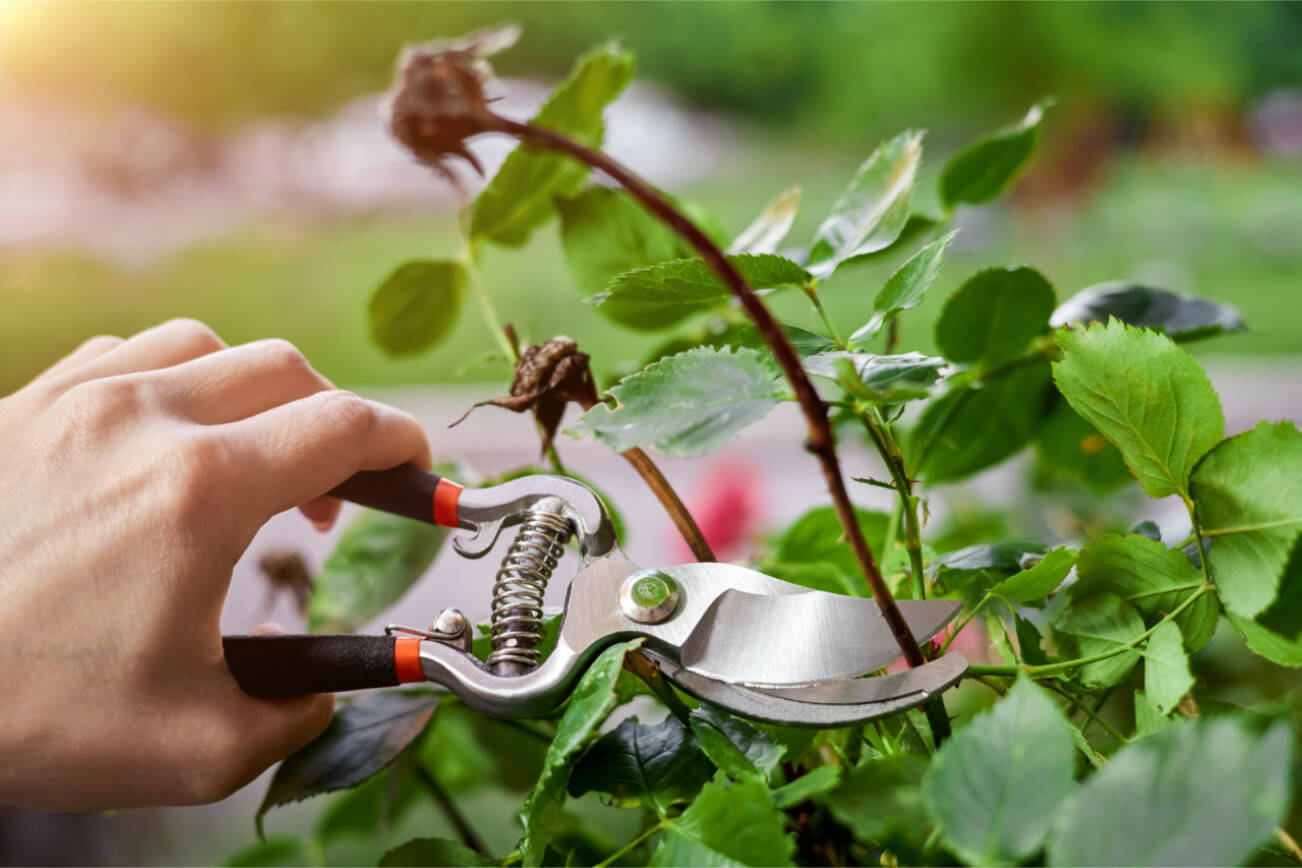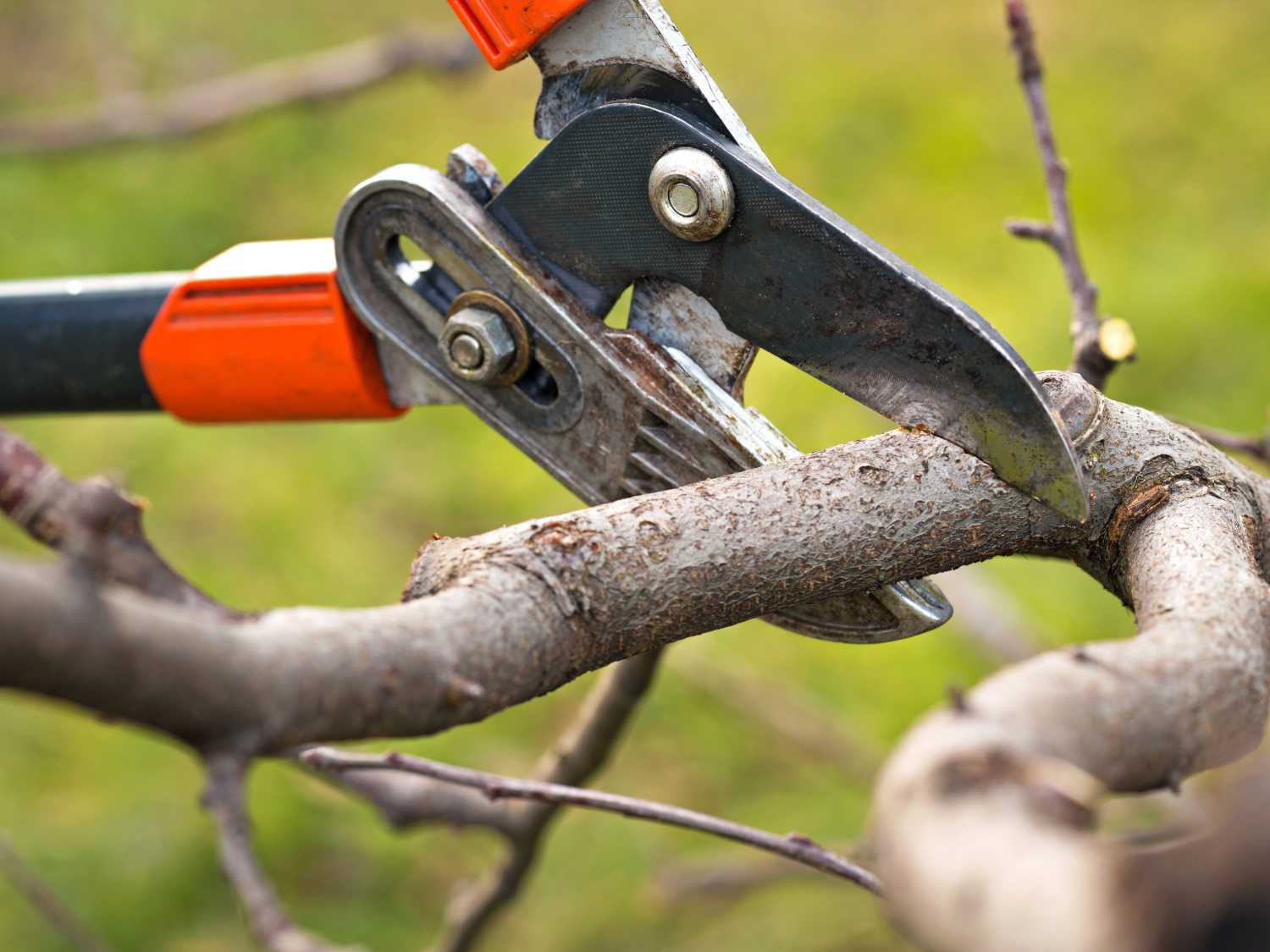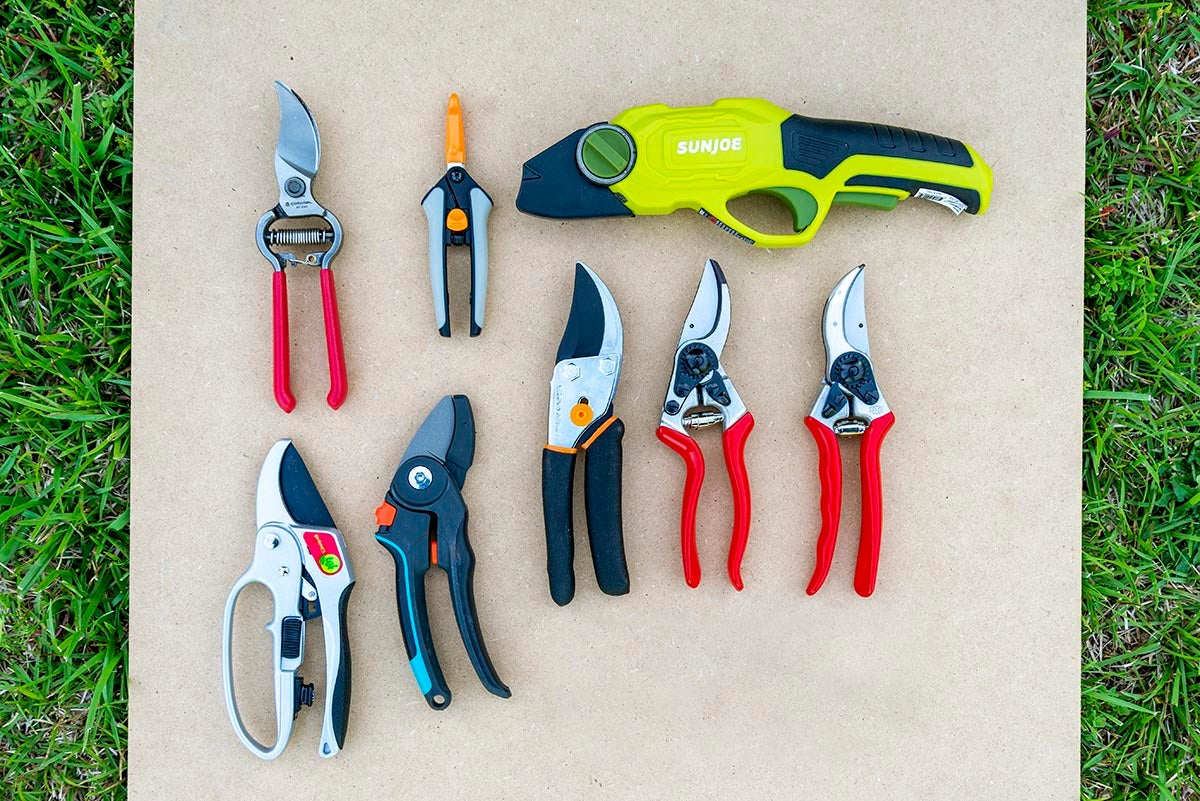Home>Gardening Basics>Tools and Equipment>What Is The Best Tool To Cut Large Branches When Pruning Shrubs That Are Hard To Reach


Tools and Equipment
What Is The Best Tool To Cut Large Branches When Pruning Shrubs That Are Hard To Reach
Modified: January 22, 2024
Discover the top tools and equipment for cutting large branches in hard-to-reach areas when pruning shrubs. Find the best tool for the job!
(Many of the links in this article redirect to a specific reviewed product. Your purchase of these products through affiliate links helps to generate commission for Chicagolandgardening.com, at no extra cost. Learn more)
Table of Contents
- Introduction
- Understanding the Importance of Pruning Shrubs
- Challenges Faced When Pruning Hard-to-Reach Shrubs
- Factors to Consider When Choosing a Tool to Cut Large Branches
- Different Types of Tools for Cutting Large Branches
- Tool 1: Pole Pruners
- Tool 2: Loppers
- Tool 3: Pruning Saws
- Tool 4: Hedge Trimmers
- Tool 5: Extendable Pruners
- Tool 6: Cordless Electric Pruners
- Comparing the Pros and Cons of Each Tool
- The Best Tool to Cut Large Branches for Hard-to-Reach Shrubs
- Tips for Safe and Efficient Pruning
- Conclusion
Introduction
When it comes to taking care of our shrubs, pruning plays a crucial role in maintaining their health and aesthetics. Regular pruning helps promote growth, remove dead or damaged branches, and shape the shrubs to enhance their overall appearance. However, pruning can be a challenging task, particularly when dealing with hard-to-reach shrubs that have large branches.
Pruning hard-to-reach shrubs requires the use of specialized tools that can make the task more manageable and efficient. With the right tool, you can safely and effectively cut large branches without compromising the health and structure of the shrub. But with the plethora of tools available on the market, choosing the best one for the job can be overwhelming.
In this article, we will explore the different types of tools available for cutting large branches when pruning hard-to-reach shrubs. We will discuss the pros and cons of each tool, as well as factors to consider when making your selection. By the end of this article, you will have a better understanding of the best tool to use for cutting large branches in those hard-to-reach areas of your garden.
Understanding the Importance of Pruning Shrubs
Pruning shrubs is an essential practice for maintaining their overall health and appearance. Regular pruning helps stimulate growth, remove dead or diseased branches, and improve air circulation within the shrub. It also allows sunlight to reach the inner parts of the plant, promoting photosynthesis and enhancing the shrub’s overall vitality.
Pruning also plays a crucial role in shaping the shrub and controlling its size. By selectively removing branches, you can help maintain the desired shape and prevent overgrowth that can become unruly and unmanageable. This is especially important for shrubs in tight spaces or for bordering paths and walkways.
Aside from the aesthetic benefits, pruning also contributes to the long-term health and longevity of the shrub. By removing dead or damaged branches, you prevent the spread of diseases or pests that can harm the entire plant. Pruning can also help correct any structural issues, such as crossed or rubbing branches, reducing the risk of branch breakage or damage during storms.
Timing is another important aspect of pruning shrubs. Different shrub species have varying growth patterns, and understanding these patterns can help you determine the best time to prune. Generally, it is recommended to prune flowering shrubs immediately after they have finished blooming to avoid cutting off next year’s flower buds. Evergreen shrubs, on the other hand, can be pruned in early spring before new growth begins.
Overall, regular pruning of shrubs not only enhances their visual appeal but also promotes their overall health and longevity. It is an essential practice for any gardener or homeowner looking to maintain a beautiful and vibrant landscape.
Challenges Faced When Pruning Hard-to-Reach Shrubs
Pruning hard-to-reach shrubs comes with its fair share of challenges. These challenges can make the task more time-consuming, physically demanding, and potentially dangerous if the right precautions are not taken. Understanding these challenges can help you better prepare and select the appropriate tools for the job.
One of the main challenges when pruning hard-to-reach shrubs is accessing the branches that need to be cut. These shrubs may be located in tight corners, against walls, or high above ground level. It can be difficult to maneuver around these obstacles and find a comfortable position to perform the pruning. This can lead to strain and fatigue on your body, especially if you need to maintain an awkward posture for an extended period of time.
Another challenge is reaching the branches themselves. Large branches located high up or deep within the shrub can be hard to reach with conventional tools. Stretching or overreaching to reach these branches can put you at risk of falling or causing damage to the shrub. It is crucial to have the right equipment that allows you to safely extend your reach without compromising your balance or stability.
When pruning hard-to-reach shrubs, visibility also becomes a concern. It can be challenging to see the branches clearly, especially if they are hidden within dense foliage or positioned in shadowed areas. Poor visibility increases the risk of making improper cuts or accidentally damaging healthy branches. It is essential to have tools that provide clear visibility and enable precise cutting without guesswork.
Lastly, some hard-to-reach shrubs may have thick or stubborn branches that require extra cutting power. Traditional hand tools may not be effective in cutting through these branches, leading to frustration and inefficient pruning. Having a tool with enough cutting capacity and leverage is crucial to tackle the larger and harder branches found in these shrubs.
By understanding the challenges of pruning hard-to-reach shrubs, you can better prepare yourself and select the appropriate tools. Overcoming these challenges will not only make the task more manageable but also ensure safe and efficient pruning, leading to healthier, more beautiful shrubs in your garden.
Factors to Consider When Choosing a Tool to Cut Large Branches
Choosing the right tool to cut large branches when pruning hard-to-reach shrubs is essential for a successful and efficient pruning session. There are several factors to consider before making your selection, as different tools have unique features and advantages. Here are some key factors to keep in mind when choosing a tool:
- Reach: Consider the height and depth of the shrub you need to prune. If the branches are high up, you’ll need a tool with an extended reach, such as a pole pruner or an extendable pruner.
- Cutting Capacity: Assess the thickness of the branches you’ll be dealing with. Some shrubs may have thicker branches, requiring a tool with a robust cutting capacity, like loppers or a pruning saw.
- Comfort and Ergonomics: Pruning can be physically demanding, so choose a tool that offers comfort and ease of use. Look for features like padded handles, adjustable lengths, and lightweight construction.
- Blade Quality: The quality of the cutting blades is crucial for clean and precise cuts. Ensure that the tool you choose has sharp, durable blades that can handle the task at hand.
- Power Source: Consider the power source of the tool. Options range from manual tools to electric or battery-powered tools. Electric or cordless tools provide more cutting power and are suitable for larger branches, while manual tools are ideal for smaller shrubs or for those who prefer a traditional approach.
- Budget: Set a budget and compare prices of different tools. Bigger, more advanced tools may come with a higher price tag, so it’s important to find a balance between your needs and your budget.
- Safety Features: Look for tools with safety features such as a locking mechanism or a safety lock. These features reduce the risk of accidental injuries during pruning.
Considering these factors will help you narrow down your options and select the best tool for cutting large branches when pruning hard-to-reach shrubs. Keep in mind that different tools excel in different situations, so choose the one that aligns with your specific needs and preferences.
Different Types of Tools for Cutting Large Branches
When it comes to cutting large branches while pruning hard-to-reach shrubs, there are various types of tools available. Each tool is designed to address specific pruning needs and offers unique features to make the task more manageable. Here are some of the most commonly used tools for cutting large branches:
- Pole Pruners: Pole pruners, also known as pole saws, are ideal for reaching high branches without the need for a ladder. They consist of a long pole with a cutting head at the end. The cutting head can be operated manually or with a rope and pulley system, allowing you to make precise cuts while keeping your feet safely on the ground.
- Loppers: Loppers are designed for cutting branches with a diameter of 1-2 inches. They feature long handles and a bypass or anvil cutting mechanism, providing leverage and cutting power. Loppers are versatile tools that can reach into tight spaces and are ideal for pruning branches that are within arm’s reach.
- Pruning Saws: Pruning saws come in various sizes and shapes, including folding saws, curved blade saws, and straight blade saws. They are specifically designed to cut through thicker branches that loppers or hand pruners may struggle with. Pruning saws are particularly useful when dealing with large branches in hard-to-reach areas.
- Hedge Trimmers: Hedge trimmers are primarily used for shaping and trimming hedges, but they can also be useful for cutting smaller branches. They feature dual-sided blades that oscillate back and forth, allowing for quicker and more efficient cutting. Hedge trimmers are best for maintaining shrubs with numerous small branches rather than for cutting large branches.
- Extendable Pruners: Extendable pruners, also known as telescopic pruners, are designed for reaching branches that are slightly out of reach. They have extendable handles that allow you to increase your reach without compromising stability. Extendable pruners are effective for cutting branches in moderately hard-to-reach areas.
- Cordless Electric Pruners: Cordless electric pruners are powered by rechargeable batteries, providing cutting power without the hassle of cords or manual effort. They are suitable for cutting larger branches and offer convenience and ease of use. Cordless electric pruners are ideal for larger pruning projects and hard-to-reach areas where a gas-powered tool would be impractical.
Each of these tools has its own set of advantages and limitations, so consider the specific requirements of your pruning tasks when selecting the appropriate tool. Assess the size of the branches, the height and accessibility of the shrubs, and your comfort level before making a decision.
Tool 1: Pole Pruners
Pole pruners, also known as pole saws, are an essential tool for cutting large branches in hard-to-reach areas when pruning shrubs. They consist of a long, extendable pole with a cutting head at the end. Pole pruners allow you to reach branches that are high above ground level without the need for a ladder, ensuring your safety and stability.
There are different types of pole pruners to choose from, including manual and powered options. Manual pole pruners require manual effort to make the cuts, while powered pole pruners utilize a rope and pulley system or a small engine to enhance cutting efficiency.
The cutting head of a pole pruner typically features a curved or bypass blade, which provides clean and precise cuts. Some models may also have additional features such as a built-in hook to assist in removing cut branches from the tree canopy.
Pole pruners are ideal for cutting branches with a diameter of up to 2 inches, making them suitable for most pruning tasks. They allow you to reach branches that are high up or deep within the shrub, ensuring thorough pruning without the risk of accidents or damage.
When using a pole pruner, it’s important to consider your safety and the safety of those around you. Ensure that the area below the pruned branches is clear to prevent any falling debris from causing harm. Additionally, be mindful of electrical wires or other obstructions that may be present in the area.
Overall, pole pruners are a versatile and effective tool for cutting large branches in hard-to-reach areas. They provide the necessary reach and cutting power to tackle pruning tasks on tall shrubs while maintaining safety and stability. Whether you opt for a manual or powered pole pruner, this tool is a valuable addition to any gardener or landscaper’s arsenal.
Tool 2: Loppers
Loppers are another essential tool for cutting large branches when pruning hard-to-reach shrubs. These tools feature long handles with a cutting mechanism at the end, making it easier to reach and cut branches that are within arm’s reach. Loppers are particularly useful for branches with a diameter ranging from 1 to 2 inches.
There are different types of loppers available, including bypass loppers and anvil loppers. Bypass loppers have two curved blades that pass by each other, providing a clean and precise cut. Anvil loppers, on the other hand, have one sharpened blade that cuts against a flat surface, making them ideal for cutting deadwood or thicker branches.
The long handles of loppers provide extra leverage, allowing you to exert more cutting power with less effort. This feature makes loppers suitable for cutting branches that may be too thick for traditional pruning shears or hand pruners.
When using loppers, it is important to use them correctly to ensure the health and integrity of the shrub. Make clean cuts just above the branch collar, which is the swollen area where the branch meets the main stem. Avoid leaving stubs or cutting too close to the main stem, as this can cause damage and increase the risk of disease or infection.
Loppers come in various sizes, so it is essential to choose one that suits the specific needs of your shrubs. Longer-handled loppers provide more reach and cutting power, while shorter-handled loppers offer more precision and control in tight spaces.
Additionally, consider the weight and ergonomics of the loppers to ensure comfortable use during prolonged pruning sessions. Look for features such as non-slip grips and lightweight materials to minimize strain on your hands and arms.
In summary, loppers are versatile tools for cutting large branches when pruning hard-to-reach shrubs. They provide the necessary reach, cutting power, and control to tackle branches with a diameter of 1 to 2 inches. With the right technique and proper selection of loppers, you can achieve clean and precise cuts, contributing to the overall health and appearance of your shrubs.
Tool 3: Pruning Saws
Pruning saws are indispensable tools for cutting large branches when pruning hard-to-reach shrubs. These saws are designed specifically to tackle thicker branches that may be too challenging for loppers or hand pruners. Pruning saws come in various sizes and shapes, such as folding saws, curved blade saws, and straight blade saws.
Folding saws are compact and portable, making them convenient for carrying around the garden. Curved blade saws have a curved cutting edge, allowing for faster and more efficient cutting. Straight blade saws, on the other hand, provide precision and control when making cuts in dense foliage.
When using a pruning saw, it is essential to approach the cutting process with caution and precision. Begin by making an initial V-shaped cut on the underside of the branch, a few inches away from the stem. This prevents the branch from tearing or causing bark damage when the final cut is made from the top.
Apply even pressure and use smooth, controlled strokes to cut through the branch. Avoid forcing the saw, as this can lead to binding or bending of the blade. Let the saw do the work, and maintain a steady cutting rhythm for smoother and more efficient cuts.
Unlike pole pruners or loppers, pruning saws require physical effort to operate. For larger pruning projects or thicker branches, consider using a pruning saw with a higher teeth-per-inch (TPI) count. Higher TPI allows for more precise and cleaner cuts, especially in denser wood.
Pruning saws are excellent tools for cutting large branches in hard-to-reach areas, such as high up in the shrub or deep within dense foliage. They are particularly useful for branches with a diameter exceeding the capacity of loppers or hand pruners.
When selecting a pruning saw, consider the size and type of branches you typically encounter in your pruning tasks. Choose a saw that balances cutting power, blade length, and ease of use. Additionally, prioritize safety by selecting a pruning saw with a secure locking mechanism to prevent accidental blade movement when not in use.
In summary, pruning saws are essential tools for cutting large branches in hard-to-reach shrubs. With their specialized blades and cutting mechanisms, pruning saws provide the necessary power and precision to tackle thick branches efficiently. By choosing the right pruning saw and using proper cutting techniques, you can ensure clean and effective pruning while maintaining the health and aesthetics of your shrubs.
Tool 4: Hedge Trimmers
While primarily used for shaping and trimming hedges, hedge trimmers can also be useful for cutting smaller branches when pruning hard-to-reach shrubs. Hedge trimmers feature dual-sided blades that oscillate back and forth, allowing for quick and efficient cutting.
Hedge trimmers are best suited for shrubs with numerous small branches rather than for cutting large branches. They can quickly and evenly trim the foliage of a shrub, giving it a neat and well-maintained appearance. If your pruning needs involve removing smaller branches and shaping the overall form of the shrub, a hedge trimmer can be a valuable tool.
When using hedge trimmers, it is important to exercise caution and ensure proper safety measures. Wear protective gear, such as gloves and safety goggles, to prevent injuries from flying debris. Be mindful of the position of your hands and keep them away from the blades at all times.
It’s also crucial to use hedge trimmers with a good grip and ergonomic design to prevent hand fatigue and improve control. Many modern hedge trimmers feature anti-vibration technology to reduce strain on the user during prolonged use.
When working with hard-to-reach shrubs, consider using a lightweight and cordless hedge trimmer for increased mobility and flexibility. Cordless hedge trimmers eliminate the need for an extension cord, allowing for better maneuverability and access to hard-to-reach areas of the shrub.
Keep in mind that while hedge trimmers are efficient for maintaining shrub shape and trimming smaller branches, they may not have the cutting capacity or reach necessary for cutting large branches. It is crucial to assess your pruning needs and consider other tools, such as loppers or pruning saws, for thicker or hard-to-reach branches.
In summary, hedge trimmers are versatile tools that excel in shaping and trimming shrubs with numerous small branches. They provide quick and efficient cutting, making them ideal for maintaining the aesthetics of hard-to-reach shrubs. However, it’s important to recognize their limitations and use other tools for cutting larger branches or branches located deep within the shrub.
Tool 5: Extendable Pruners
When pruning hard-to-reach shrubs, extendable pruners can be a valuable tool to have. Also known as telescopic pruners, these tools feature an extendable handle that allows you to increase your reach without compromising stability or control.
Extendable pruners are designed for branches that are slightly out of reach but still within a reasonable distance. They provide an extra few feet of reach, making it easier to access branches in high or awkward positions. With an extendable pruner, you can safely and comfortably prune branches without the need for ladders or precarious positions.
These pruners typically have a cutting head similar to traditional hand pruners, but with an extended reach. The cutting mechanism can be operated by squeezing a handle, which triggers the movement of the cutting blade. Some models also feature a ratchet mechanism that allows for easier cutting of thicker branches.
When using extendable pruners, it is important to maintain balance and stability. Ensure that the pruner is fully extended and locked in place before making any cuts. Use a firm grip and steady cutting motion to prevent slipping or accidental damage to the shrub.
There are both manual and powered options available for extendable pruners. Manual extendable pruners require physical effort to make cuts, similar to traditional hand pruners. Powered extendable pruners, on the other hand, utilize a small engine or motor to enhance cutting power and efficiency.
Choosing the right extendable pruner depends on your specific needs and preferences. Consider factors such as the maximum reach needed, the weight of the pruner, and the cutting capacity. Opt for a pruner with durable blades that can handle the size of branches you typically encounter during your pruning tasks.
Overall, extendable pruners are versatile tools that provide extended reach when pruning hard-to-reach shrubs. These tools offer convenience, safety, and control, allowing you to achieve precise cuts without compromising stability or balance. By adding an extendable pruner to your arsenal, you can effectively prune branches that are just out of reach, ensuring the health and aesthetics of your shrubs.
Tool 6: Cordless Electric Pruners
For those seeking convenience and cutting power when pruning hard-to-reach shrubs, cordless electric pruners can be a game-changer. These pruners are powered by rechargeable batteries, eliminating the need for cords or manual effort. Cordless electric pruners offer increased cutting capacity and efficiency, making them suitable for larger branches and more extensive pruning projects.
One of the key advantages of cordless electric pruners is their cutting power. These pruners are designed to cut through thicker branches effortlessly, saving considerable time and effort compared to manual or hand tools. They are particularly beneficial when dealing with hard-to-reach areas with branches that exceed the cutting capacity of traditional pruners.
Another advantage of cordless electric pruners is their convenience and portability. Without the restriction of cords, these pruners allow for greater maneuverability, making them ideal for navigating around shrubs and hard-to-reach branches. The cordless design also ensures ease of use in areas without access to power outlets, such as remote corners of the garden or larger landscapes.
Cordless electric pruners are equipped with rechargeable batteries, usually lithium-ion, which offer extended run time and quick charging. This allows for uninterrupted pruning sessions and reduces downtime between uses. It is important to consider the battery life and charging time when selecting a cordless electric pruner to ensure it meets your pruning needs.
When using cordless electric pruners, it is essential to follow safety guidelines. The powerful cutting action requires a steady and controlled approach to prevent accidental injury or damage to the shrub. Always wear appropriate protective gear, such as gloves and safety goggles, and be cautious of your surroundings to avoid accidents.
Consider the weight and ergonomics of cordless electric pruners to ensure comfortable use during pruning sessions. Look for models with features such as anti-vibration technology and ergonomic handles to minimize fatigue and improve control.
While cordless electric pruners offer many advantages, they are typically more expensive than manual or traditional power tools. However, the increased cutting power and convenience they provide can outweigh the cost, especially for those with extensive pruning needs or hard-to-reach areas in their garden.
In summary, cordless electric pruners are powerful and portable tools for cutting large branches in hard-to-reach areas. They offer convenience, cutting efficiency, and extended run time, making them suitable for larger pruning projects and shrubs with thick branches. By investing in a cordless electric pruner, you can enhance your pruning capabilities and achieve clean and precise cuts with ease.
Comparing the Pros and Cons of Each Tool
When it comes to choosing the best tool for cutting large branches when pruning hard-to-reach shrubs, it’s important to consider the pros and cons of each tool option. Let’s compare the advantages and disadvantages of the tools discussed:
- Pole Pruners:
- Pros: Provide extended reach, eliminate the need for ladders, and offer a safe and stable platform for cutting high branches.
- Cons: May have limited cutting capacity for thicker branches and can be challenging to maneuver in dense foliage.
- Loppers:
- Pros: Provide leverage and cutting power, suitable for branches up to 2 inches thick, and versatile for pruning tasks within arm’s reach.
- Cons: Limited reach and may not be ideal for hard-to-reach branches or dense shrubs.
- Pruning Saws:
- Pros: Designed for thick branches, offer different shapes and sizes for various pruning needs, and can reach branches in hard-to-reach locations.
- Cons: Require physical effort, may not have the reach of pole pruners, and can be less precise than loppers.
- Hedge Trimmers:
- Pros: Efficient and quick for trimming numerous small branches and shaping shrubs, suitable for maintaining tight spaces.
- Cons: Limited for cutting larger branches, may not be effective for hard-to-reach areas or branches above shoulder height.
- Extendable Pruners:
- Pros: Provide extended reach for branches just out of arm’s reach, ensure stability and control, and are versatile for various pruning tasks.
- Cons: Limited reach compared to pole pruners, may not have the cutting capacity for thicker branches.
- Cordless Electric Pruners:
- Pros: Powerful cutting action, convenient cordless design, suitable for larger branches and harder-to-reach areas.
- Cons: Higher cost, may have limited battery life, and require appropriate safety precautions.
When selecting the best tool, consider the specific needs of your pruning tasks, such as branch size, reach, and shrub density. It may be beneficial to have a combination of tools to address various pruning situations.
Ultimately, the best tool will depend on the unique requirements of your pruning project, your comfort level, and your budget. By assessing the pros and cons of each tool, you can make an informed decision and ensure successful pruning while maintaining the health and aesthetics of your hard-to-reach shrubs.
The Best Tool to Cut Large Branches for Hard-to-Reach Shrubs
Choosing the best tool to cut large branches for hard-to-reach shrubs depends on various factors, including the size of the branches, reach required, and personal preference. While each tool has its advantages and limitations, one tool stands out as the top choice for cutting large branches in hard-to-reach areas: the pole pruner.
Pole pruners offer the perfect combination of reach, cutting power, and safety. With their long, extendable poles, pole pruners allow you to access high branches without the need for a ladder, ensuring stability and reducing the risk of accidents. They provide the reach necessary to cut branches in hard-to-reach areas, even deep within dense shrubbery.
Pole pruners are specifically designed for pruning tasks, equipped with cutting heads that can handle branches up to 2 inches in diameter. Many pole pruners also offer adjustable cutting angles or rotating heads, allowing for precise cuts at various angles and in tight spaces.
Additionally, pole pruners are relatively easy to use and require less physical effort compared to other tools like pruning saws or loppers. By operating the cutting head with a rope and pulley system or a manual mechanism, you can make controlled and precise cuts while maintaining a safe distance from the branch.
While other tools like loppers and pruning saws have their advantages in certain scenarios, pole pruners offer a comprehensive solution for cutting large branches in hard-to-reach areas. Their combination of reach, cutting power, and safety make them the top choice for efficient and effective pruning of hard-to-reach shrubs.
It’s important to note that choosing the best tool ultimately depends on the specific requirements of your pruning task and your own preferences. Assess the height, reach, and thickness of the branches you typically encounter and consider your comfort level when making your final decision.
By selecting the pole pruner as your go-to tool for cutting large branches in hard-to-reach shrubs, you can ensure safe, precise, and efficient pruning while maintaining the health and beauty of your shrubs.
Tips for Safe and Efficient Pruning
Pruning shrubs, especially in hard-to-reach areas, requires proper techniques and precautions to ensure both safety and efficient results. Here are some essential tips to keep in mind when pruning:
- Wear protective gear: Always wear appropriate protective gear, including gloves, safety goggles, and long sleeves. This will protect you from potential injuries caused by thorns, falling debris, or accidental slips.
- Choose the right tool: Select the appropriate tool for the task at hand. Consider the size of the branches, the reach required, and your comfort level. Using the right tool will make pruning safer and more efficient.
- Inspect the area: Before starting the pruning process, thoroughly inspect the area for potential hazards such as electrical wires, unstable footing, or nearby obstacles. Clear the area to prevent accidents and ensure a safe working environment.
- Start with dead or diseased branches: Begin by removing dead or diseased branches. This will improve the health of the shrub, reduce the risk of disease spread, and make it easier to identify and shape the remaining branches.
- Make proper cuts: Use the appropriate cutting technique for the type and size of the branch. Cut just above the branch collar, which is the swollen area where the branch meets the main stem, to promote healing and prevent damage to the shrub.
- Prune during the right time: Prune shrubs during the appropriate season for your specific plant variety. Some shrubs should be pruned after blooming, while others can be pruned in early spring. Research the specific pruning requirements for your shrubs.
- Don’t over-prune: Avoid excessive pruning, as it can stress the shrub and affect its overall health and growth. Remember to maintain the natural shape and structure of the shrub while removing excess or unwanted growth.
- Take breaks: Pruning can be physically demanding work. Take regular breaks to rest and stretch to prevent muscle strain or fatigue. Hydrate yourself adequately during the pruning process.
- Dispose of debris: Properly dispose of pruned branches and debris to keep your work area clean and reduce the risk of tripping or spreading pests and diseases.
- Continuous maintenance: Regularly monitor your shrubs and perform ongoing maintenance to address any new growth, dead branches, or shaping needs. This will help maintain the health and appearance of your shrubs over time.
By following these tips, you can ensure safe and efficient pruning of hard-to-reach shrubs. Remember to prioritize safety, use the right tools, and practice proper cutting techniques. With a mindful approach, your shrubs can thrive and contribute to a beautiful and well-maintained landscape.
Conclusion
Pruning hard-to-reach shrubs with large branches doesn’t have to be a daunting task. By selecting the right tools and following proper techniques, you can efficiently and safely prune your shrubs, enhancing their health and aesthetics.
When choosing a tool, consider factors such as reach, cutting capacity, comfort, and budget. Pole pruners, with their extended reach and cutting power, are often the top choice for cutting large branches in hard-to-reach areas. Loppers, pruning saws, hedge trimmers, extendable pruners, and cordless electric pruners each have their own advantages and limitations, catering to specific pruning needs and preferences.
Remember to prioritize safety: wear protective gear, inspect the area for hazards, and take breaks to prevent fatigue. Make proper cuts, remove dead or diseased branches first, and prune during the appropriate season. Dispose of debris properly and practice continuous maintenance to keep your shrubs healthy and well-groomed.
Whether you are a passionate gardener or a homeowner looking to maintain a beautiful landscape, mastering the art of pruning hard-to-reach shrubs with large branches is a valuable skill. With the right tools, techniques, and safety measures, you can transform your shrubs into stunning focal points of your garden, ensuring they thrive and contribute to the overall beauty of your outdoor space.


